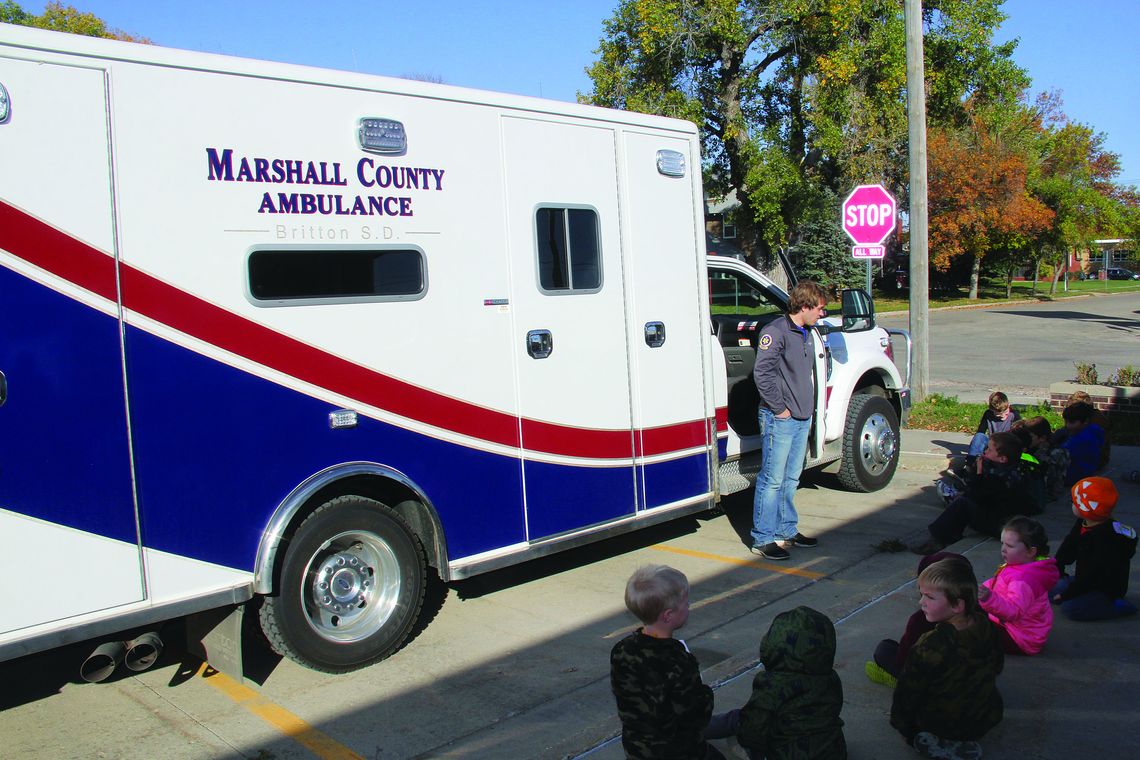The sound of sirens and glimpse of flashing lights is familiar in both urban and rural areas. In Journal Country, these lights and sirens may belong to a Marshall County Ambulance (MCA). In fact, that local emergency service responds to between 200 and 300 calls per year. That is all the more impressive when considering that the MC ambulance crew is quite small at just over five volunteers. Though they are not alone in dwindling numbers considering trends state and nationwide, county officials would like to see those numbers increase.
Rural emergency medical services in South Dakota are mostly volunteer-based. This is also true of MCA crew members, though volunteers may receive stipends depending on their duties paid through the county commission.
MCA volunteers emphasize that they find their work on the crew very rewarding and variable. “Though we are never seeing people on their best day, it’s important to be able to help someone, whether you’re just holding their hand or saving their life,” said Pam Bard of the MCA.
Locally, EMTs respond to many different types of calls and help in numerous ways. “On any given day, we might do transfers to Aberdeen, help with lift assists, do a fire standby, respond to a Life Alert notice or go to the scene of an accident,” added Bard.
Unfortunately, a recently released report commissioned by the state Department of Health found that volunteer levels are forecasted to decline in the next five to 10 years. That makes recruitment and retention one of the greatest challenges for South Dakota ambulance services.
Yet, these services and the timeliness of them are vitally important. A Journal of the American Medical Association article found that nationwide, emergency medical service units average seven minutes from the time of a 911 call to arrival on scene. That median time increases to more than 14 minutes in rural settings, with nearly 10% of encounters waiting almost a half hour for the arrival of EMS personnel. Longer EMS response times were also associated with worse outcomes in trauma patients.
In Marshall County, EMTs are putting their best foot forward despite dwindling numbers. Bard noted the local service has three ambulances. But having enough personnel to drive and man those three ambulances can be tricky. “It can be difficult to cover in some cases,” said Bard. “If things get bad, we would call everyone in, but you can’t guarantee everyone can respond.”
She adds that there always needs to be a backup crew in case another call comes in. In some instances, they call a local fireman in to drive an ambulance. Marshall County Emergency Management Director Logan Roehr who also works on the MCA crew emphasizes that they have not gotten to the point where they couldn’t respond to something, but that is a concern. In that case, waiting for a crew from a neighboring county might take precious time.
The local hospital also reiterated the importance of ambulance services on their end as well. “Without sufficient EMS services, it is difficult for our hospital to receive emergent patients,” said Marshall County Healthcare Center CEO Nick Fosness. “Additionally, we need EMS to transport patients that need next level care from our hospital”.
Consequently, county officials are hoping to boost ambulance crew numbers. “It is the county’s duty to support and maintain our 24/7 first responders services such as fire, ambulance, and police,” said Marshall County Commissioner Jason Bender. “We’re fortunate to have all of this and an amazing hospital in town. We need to do what we have to to maintain those services.”
The process of becoming an EMT might seem daunting but thanks to technology it can be more manageable. Classes are offered online through several different outlets, including technical colleges and healthcare providers like Sanford. Roehr adds that he hopes to get an in-person class going in Marshall County in the next few months.
There is coursework plus required ride-alongs, explained Roehr. EMTs will also need to be certified by the National Registry of Emergency Medical Technicians. This process requires that applicants complete a two-part examination. The first part of the exam is the cognitive or computer based multiple choice test. The practical segment of the exam is constructed to test physical aptitude with regard to the skills necessary to be an EMT.
Bard notes that a dedicated person could complete this all in less than six months. When asked how many people would be required to make up a more robust Marshall County crew, Roehr said, “The more, the merrier.”
“I would like to invite anyone interested in learning more to reach out to an ambulance crew member or come to one of their or the commission’s meetings to visit with the ‘boots on the ground,’” said Bender. “This is a great way to give back to your community.”
“Our EMT crew is always there for us,” stressed Fosness. “It’s easy to take ambulance service for granted, but if you’ve had a loved one in need, it’s quickly obvious that our EMTs are one more reason we are fortunate to live in this area.”
For more information about the Marshall County Ambulance crew and how to get involved, email [email protected] or reach out to a crew member.



